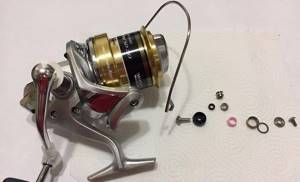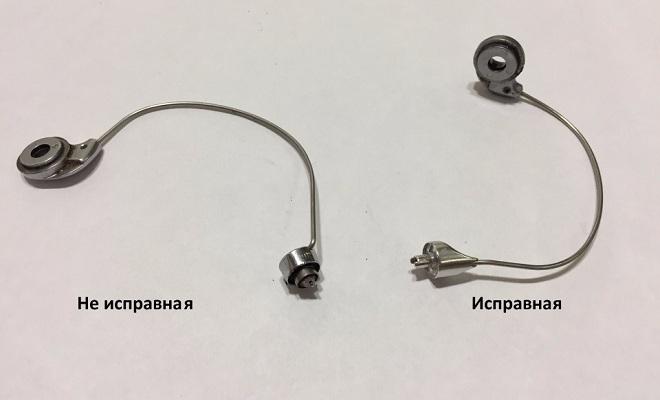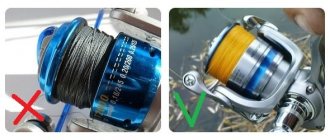A modern technological fishing rod, be it a spinning rod or a float rod, must be equipped with one of the types of reels. Most often, this element of equipment is an inertia-free, easy-to-use and affordable option. When purchasing a mechanism, an angler expects long-term use of the product with minimal maintenance costs. But one way or another, sometimes you have to deal with some malfunctions of the device, which in most cases can be repaired yourself, without resorting to the services of professional technicians, thus saving both time and money, and ultimately gaining confidence in the well-functioning operation of the mechanism.
We will present to the reader's attention a number of minor troubles that can happen to an inertia-free machine during its operation, but such breakdowns are quite capable of being corrected by any fisherman who is more or less familiar with plumbing work.
The structure of inertia-free coils
Undoubtedly, in order to repair a coil you need to understand its structure and operating principle. Without exception, all inertia-free motors are assembled in the factory from the same type of units, which differ in size depending on the size of the mechanism. The main components of the device are the following parts and details of the product:
- frame;
- gear drive;
- brake clutch;
- rotor;
- reel seat support;
- rear direction switch;
- spool mounting rod;
- line layer with bow and roller;
- gear wheel with shackle.
Depending on the modification and purpose of the inertia-free grinder, or as fishermen also call it, a meat grinder, it can be supplemented with specific functionality inherent in a particular model.
How to disassemble a coil
Before planning to repair a fishing reel with your own hands, you should worry about the availability of the necessary materials and tools. For these purposes, the fisherman will need a small and medium-sized figured and flat screwdriver, pliers, tweezers, an awl, a soft and hard hair brush, an oil can, a piece of rags, as well as any type of cleaning agent containing alcohol and a special mineral oil intended for lubricating rubbing parts. device details.

It is convenient to carry out repair manipulations on a desk under a bright lamp with a white spectrum of light, on a backing made of a sheet of white paper, where small parts and connecting elements of the product will be clearly visible.
Disassembling the coil
The coil is disassembled according to the clear algorithm presented below. In the process of performing work, it is important to remember the order of the sequence of operations and scrupulously delve into the nuances that contribute to the accuracy of the work associated with the application of efforts to disconnect the threaded, bushing and locking connections of the elements and assemblies of the product.
- unscrew the nut of the brake system and the spool;
- remove the gears and washers located under the spool;
- remove the reel handle;
- unscrew the clamp nut in the mechanism;
- disassemble the rotor;
- dismantle the line-laying bow;
- dismantle the line guide latch mechanism;
- dismantle the line pulling roller;
- unscrew the screw of the reverse locking device;
- dismantle the switch lever;
- unscrew the plug screw;
- dismantle the plug;
- dismantle the wall.
Disassembling the line roller
After manipulating the parts and the body of the mechanism, we proceed to disassembling the line layer. It is not possible to construct an unambiguous algorithm for dismantling the parts of this element, due to significant differences in the design of the device in each version of the device. To ensure the reliability of the work, it is recommended to take step-by-step photographic recording of each operation performed, which today is quite accessible to the average person using a smartphone for these purposes.
Having recorded the disassembly process in photographs, after diagnosing and repairing the spinning reel, the fisherman can easily cope with its reassembly, bringing the product back to its original and functional form without errors.

The most popular problems and their repairs
In continuation of the article, we will look at a number of the most common problems with inertialess motors. These problems, which are not critical for the complete failure of the mechanism, can be associated both with defects in the materials of the product and with incorrect operation of the device. After all, the unfavorable conditions under which the meat grinder units operate, such as high humidity, abrasive sand particles and elementary dirt, certainly only have a negative impact on the operation of the unit as a whole, despite the scrupulousness and care with which it is treated.
But often, in fishing practice, even if the minimum rules for using inertia-free gear and regular maintenance of gears and bearings are observed, these troubles occur due to exhausted periods and resources exceeding the maximum capabilities of the components and parts of the product. The presented reel breakdowns should not confuse or unsettle the fisherman, because he should be able to put the device in order on his own, which is quite doable.
Reverse stop failure

When faced with a situation where the handle begins to rotate freely in both directions when the lock is on, this indicates serious contamination or thickening of the lubricating substances caused by large amounts of dust entering them. The problem of failure of the reverse stopper is solved as follows: the fisherman needs to unscrew the screw of the reverse stopper and remove the clutch. Then the unit is thoroughly cleaned of dirt and old lubricants, rinsing the cleaned surfaces with white spirit or solvent. After these manipulations and drying, fresh lubricant is added and reassembled. The functionality of the unit is restored to its original state.
Spiral line feed
Feeding a fishing line in a spiral when casting baits is one of the common problems in the operation of spinning gear, which can be solved in a fairly simple way, because the problem of incorrect operation lies in the clogging of the line roller. The essence of repairing a spinning reel when this problem occurs is to clean the line-laying mechanism assembly from dirt.

You will need to disassemble the line roller, following the recommendations presented in our article in previous chapters, and remove visible blockages with a brush, followed by washing the parts. Having lubricated the unit again, it is assembled sequentially and the device is used comfortably.
Line breaks under the clutch nut
The problem in question threatens the loss of baits and is inherent in new, newly acquired mechanisms with a front position of the friction brake adjustment knob, during the so-called running-in of the reel on the first fishing trips. In devices of these designs, the locking nut is raised above the edge of the spool to a height of 1–2 mm. When an angler reels in the rig, the line often gets caught on the nut and gets pulled under the edge of the spool, causing further tangling, deformation and line breakage. To eliminate incorrectness during winding, it is necessary to disassemble the spinning reel with the spool line, unscrew the clamping nut with the washers of the friction brake device and replace the factory felt pad with one of exactly the same size, only cut from thin plastic.
Important! Particular attention is paid to the problem when purchasing inexpensive mechanisms, in which manufacturers most often sin by installing low-quality gaskets in this unit.
Noise inside the coil

Noise inside the mechanism body can indicate both minor and serious problems. If you hear extraneous sounds in the form of creaks or rattles, you should stop using the device until the essence of the problem is clarified. In any case, you will need to disassemble the spinning reel and visually inspect the transmission mechanism. The reason may lie in the penetration of contaminants into the housing, when sand and solid dust fractions get onto the surfaces of gears and shafts, as well as into the working parts of bearings.
The problem is solved by mechanical cleaning and washing of the unit, followed by adding fresh lubricants. If deformation of parts and bearings is detected, which is most likely, they will need to be completely replaced with new spare parts.
Uneven line winding
Uneven winding of the fishing line is typical of old, long-life devices. The problem manifests itself in the form of a cone-shaped front laying of the cord during winding, or the same rear winding of the line onto the spool. If a conical arrangement is formed in the front part, the washer should be completely removed and removed from the main shaft of the part.

An option for repairing an inertia-free coil when winding with a cone upward is to add another washer to the shaft, compensating for the resulting wear. In both cases, the problem is eliminated in full, allowing you to wind the cord in the original, convenient for casting and originally designed factory style.
The reel mechanism jams under load
If the reel mechanism jams under load, then there is a high probability that the driven or drive gears will need to be replaced. To determine this, diagnostics will be required, which consists of disassembling the housing and visually inspecting the transmission mechanism to identify defective parts. The problem arises due to poor-quality material of gears and toothed shafts, as well as due to the long service life of the inertia-free drive. Symptoms of the problem initially appear as light knocking inside the case, which subsequently turns into a limp when turning the handle, and then into its jamming and jamming even under minimal loads. It is worth considering that to fix the problem you will need spare parts that fit the parameters.
Damage to the reel spool
Damage on the sides of the spool is considered an unpleasant defect. Most often, a problem of this nature occurs as a result of shock loads on the body of the device, less often, and this problem is of a low-quality product, it is caused by the use of rigid cords. Microcracks, chips and nicks appear on the side of the spool. When casting, the descending line clings to obstacles and uneven parts of the part, which leads to a decrease in the range of the tackle, and in the worst case, to deformation of the cord and its further breakage, even with minimal load.

Do-it-yourself repair of a spinning reel involves grinding the side of the spool and completely eliminating irregularities and roughness that lead to discomfort when casting and reducing the breaking loads of the line. For these purposes, sometimes it is enough to use fine abrasive sanding paper and a couple of minutes of easy-to-perform work.
Self-tightening of the clutch
Self-tightening of the clutch, to the great regret of the fisherman, should be classified as a malfunction in which it is not possible to repair a spinning reel. The problem often causes the line to break, especially if fishing is carried out on delicate gear with small diameter cords, suddenly appearing when the thread is released. When fishing with heavy gear with thick cords, spontaneous clamping of the clutch can result in a breakdown of the transmission mechanism itself. An irreparable defect is the fate of poor-quality assembly of a cheap product, which, if possible, should be returned under the manufacturer’s warranty and a new product purchased.
Self-resetting line handle

An irritating defect during fishing is a defect in the device, in which the line-laying arm self-resets, which occurs in the cord rewinding mode. In one of the repair options, the problem can be resolved by tightening the clamping screws securing the bow. If tightening the mounting screws does not resolve the issue of incorrect operation, it is worth increasing the stiffness of the spring located under the device cover. There are two ways to adjust the required spring stiffness: install a spacer on the rod, reducing the working stroke of the spring, or replace the original part with a spring with greater rigidity.
Cleaning the line roller
Cleaning the line roller should be perceived by the fisherman as a regular DIY repair of the reel after a certain period of use. The device is carefully disassembled into individual parts, which, with the exception of the bearing, are thoroughly washed in solvent to completely remove all dirt. After washing, the components of the assembly are wiped dry with napkins or a piece of soft cloth. Reassembly should be accompanied by applying a small amount of lubricant to each joint made.
Important! Excessively added lubricants, when leaking from the joints, can get on the cords and cause irreversible defects on their surface.
The bearing is wiped with a rag and lubricated in the same way as other parts. When screwing the connecting bolts, avoid tight tightening that affects the freedom of rotation of the roller. After assembly, the roller should rotate freely at the slightest touch in the direction of movement.
Fixing the fishing line on the spool
The fishing line must be securely tied to the reel. This is the basic rule that every fisherman should follow.
The fact is that no one knows what kind of fish will be hooked. It is possible that the trophy will be so large that it is easy to exhaust the entire supply of fishing line and, if the thread is not secured to the reel, the fisherman will lose both gear and catch.
You can tie the fishing line to the reel using any self-tightening knot. The most popular options are the clinch, double loop and axial knot.
To make the fastening more reliable, the first loop is secured to the reel with adhesive tape or tape. This must be done strictly in the direction of winding, otherwise the loops will begin to get tangled. This trick has one more advantage: even if the loops are not fixed tightly, they will not begin to scroll on the spool (Figure 3).

Figure 3. To prevent the thread from falling off, it is fixed with special fishing knots
In addition, experienced fishermen recommend moistening the knot before tightening. This applies to all fishing gear. A slight wetting will help improve the bond's hold.
How to attach fishing line to a spool
First of all, you need to secure the fishing line to the reel spool. Beginning fishermen often neglect this point, believing that a large amount of thread on the spool will prevent the loss of gear. But, if the fish is large, it can easily unwind the entire fishing line and drag the tackle to the bottom.
To secure it, it is not at all necessary to knit complex knots. A standard self-tightening connection is sufficient. It ties quickly and holds very firmly.
Another useful trick is that the fishing line can be secured to the spool using tape and adhesive tape in the direction of the cord. But it is important to avoid making the layer of adhesive too thick, otherwise it will change the course of the cord and the thread will unwind incorrectly.
Care and prevention of breakdowns
Maintenance and prevention of breakdowns of inertia-free motors is not at all complicated.
Important! The fisherman should consider mandatory pre-season maintenance of the device as a rule, as well as basic surface cleaning and removal of moisture from the product after each fishing trip.
In addition, it is worth ensuring that the mechanism is carefully transported, avoiding shocks and falls. When fishing, you shouldn’t put rods and reels on the sand, and also try to lower the device into the water as little as possible. Attention and careful attitude to the gear as a whole prolongs the operational potential of each element of the gun for a long time, including the inertia-free reel we examined.
Content
- Selecting drive gear axial play
- How to secure the rotor locknut?
- Elimination of axial play of a fixed knob
Every year we are faced with the need to service a spinning reel. Usually, cleaning and lubricating the insides is not difficult. But what to do when coil maintenance requires more? How to determine and eliminate the cause of the “growling” of the coil? How to restore a damaged part? Yes, we can always put it in the hands of a specialist by paying for his services. And in a number of cases, this will be the right decision. However, our forum has accumulated a lot of useful information on this topic and we considered it very useful to prepare a series of articles that will touch on some topics of self-service of inertia-free machines.
Articles will be generated based on materials from user Prank in the discussion topic “Independent maintenance of an inertia-free coil.” The contribution of Vladimir (Prank) to the development of the topics of inertia-free and multiplier reels and, in particular, repairs, modifications, and various nuances of operation is difficult to overestimate. There is so much constructive and correctly presented information that even in a series of articles we will only touch on a small part.
Today we’ll talk about how to eliminate some of the play and movement of the rotor nut.











